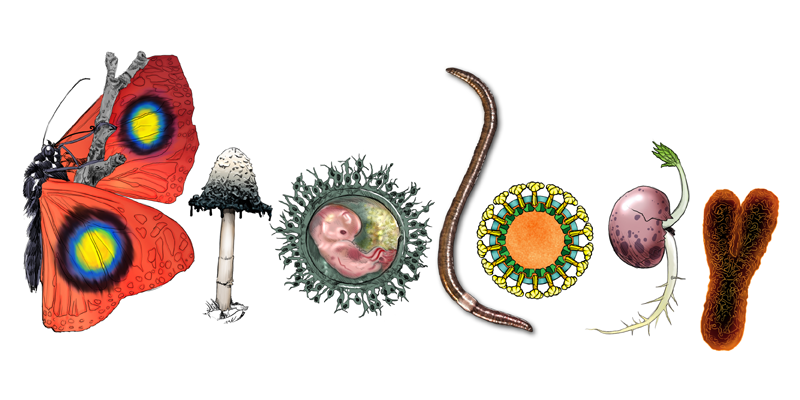Keystone species
Article curated by Rowena Fletcher-Wood
The Stockholm Declaration on the Human Environment says we have the fundamental right to freedom, equality and adequate conditions of life, in an environment of a quality that permits a life of dignity and well-being.
But that might not be straightforward: should we, for example, have the freedom to do things that might compromise the quality of our environment (like burning coal), and can we even decide without fully understanding the impact of our actions?
Although we have come a long way in understanding climate change, there is still so much we don’t know - not whether climate change is real, nor if we are causing it: 97% of scientists agree that is and we are - but it’s less clear what changes are occurring in the climate and nature. We’re still learning new things about nature, and the interconnectedness that exists in it.

Statistical biology is concerned with modelling how changes in one population affect the whole ecosystem, such as how fewer rabbits deplete fox populations, and in turn fewer foxes boost rabbit populations until a balance is restored. Habitats may also be affected by changing numbers of species, and climate change may alter habitats too, initiating migration and further disturbances within ecosystems. Food pyramids or trophic levels have long been used to describe the up down relationship between members of an ecosystem as well as the the energy loss/inefficiency of the system.
Learn more about Global warming.


 2
2![Trophic levels CK-12 [CC BY-NC 3.0]](/img/sci/Trophiclevels.jpg)
Recently, the discovery of trophic cascades, the impact of top predators on the whole food chain right the way down to the bottom, has led to new questions about human impact. Humans regularly kill other, competing top predators, sometimes for prestige, sometimes for resources and sometimes in a tug of war over shared foods. They may also be killed incidentally because of human actions, such as climate change. Politicians have argued that killing whales will boost fish numbers and so provide more food for humans, but instead a trophic cascade takes place: as whale numbers drop, so do those of fish and krill. This means that whales act as keystone species, creating profound domino effects on other members of their food chain and the surrounding environment.
Learn more about The ecological role of sharks.


 2
2
Although they eat fish and krill, whales also sustain the plankton upon which fish and krill feed. Whale faeces, released near the surface of the ocean, are rich in iron and nitrogen that act as plankton fertilisers. Whales also create vertical mixing of currents, pushing plankton to the surface where it is light enough to photosynthesise. They are as powerful at this mixing as the wind, waves and tides combined. However, it seems that the actions of whales are more far reaching than regulating the ecosystem: plankton are responsible for removing tens of millions of tonnes of CO2 from the atmosphere every day, which is eventually fixed as carbon on the ocean bed. Whales regulate climate change. Increasing whale numbers would be a way of geo-engineering carbon capture and storage, but unfortunately the very problem we want them to fix is killing them.


 2
2
Climate change affects whales in many ways. As global water temperatures increase ice at the north and south poles melts, and so seawater salinity drops. As a result, ice cover for foraging Arctic species like the bowhead, narwhal, and beluga is lost and their habitat shrinks. CO2 dissolution then increases the acidity of the ocean - and if these things don’t directly affect whales, they affect their food supply. Krill, for example, are vulnerable to increased UV exposure, and their numbers are dropping. Warmer oceans may mean an increase in disease spread. What is more, whales are very sensitive to the temperature of the water in which they live and, like many marine animals, it’s thought that reproduction may be affected. Although this is not known for sure, it is an extremely worrying prospect: climate change could have a rolling impact, accelerating itself by killing off the animals that help to regulate the atmosphere. Unlike the rabbit-fox example, leaving nature alone might not restore balance.
Learn more about Evolution and Climate Change.


 4
4Wolves are also top predators that have been implicated in trophic cascades. The best studied example of this is the 1995 reintroduction of a small pack to Yellowstone National Park in the USA. Initially, the wolves simply impacted the out of control deer population - not merely by depleting their numbers, but also by discouraging them from wandering into valleys and gorges where they might get trapped. This allowed the well-munched valleys to regenerate, becoming denser, woodier and more biodiverse, sporting the growth of berries that attracted birds, bears and beavers, which themselves went on to boost the ecosystem. Killing coyotes in the area also boosted rabbit and mouse populations, so that birds of prey migrated to the area, along with other small predators such as weasels and foxes. Most importantly, however, the wolves changed the course and nature of the Yellowstone rivers. Reinforced by the roots of new greenery, they travelled straighter and deeper, attracting fish, frogs, ducks and otters that found shelter around the beaver dams. The effect of the Yellowstone wolves on rivers remains one of the most stunning examples of how a small number of interactive species can exert huge influences in physical geography.



Less impactful, but still crucially important is the effect of bats on biodiversity. These insectivores play a range of ecologically important roles, including biological pest control, eating up to a quarter of their body weight in insects and fruit every night. It is believed that 99% of crop-eating insects are removed by natural predators including bats[1], drastically reducing the demand for chemical pest control that damages the environment and ecosystem. They are also seed dispersers and nectar-drinking pollinators for a number of significant tropical species including the mango, banana, cocoa, durian, guava, and agave used to make tequila. Their contribution has been recorded in up to 528 species[2] which seldom overlap with the scope of the bee: bees are active on brightly-coloured diurnal flowers: bats chiefly pollinate flowers with pale nocturnal flowers. With a migratory range that may exceed 1000 km, bats also contribute to material and nutrient distribution, enhancing soil fertility and forestation. Migrating bats create temporary habitats that regenerate after they move on, facilitating nutrient transfer and encouraging reforestation. Bats even act as an "indicator species"[3]: when a habitat has been contaminated or disturbed, we observe long and short term strain in bat populations. Their diet, longevity, and mobility and distribution make them especially suitable for this. Although they are not top predators, bats occupy high trophic levels, and are especially sensitive to toxin accumulation along the food chain.
Learn more about Bats and biodiversity.


 3
3Although many of the places where these changes are happening are as-yet unknown and unexplored, the idea of trophic cascades is still a fascinating concept, opening up new avenues for exploration in ecology and statistical biology. The connections between top predators and the natural world are subtle, deeply interconnected and profound. We might have thought it was just humans with concrete cities that modify nature, but it isn't - whales change oceans, wolves change rivers, and bats change habitats, and are changed by them in return.
This article was written by the Things We Don’t Know editorial team, with contributions from Cait Percy, Johanna Blee, and Rowena Fletcher-Wood.
This article was first published on 2018-01-28 and was last updated on 2018-02-08.
References
why don’t all references have links?
[1] M. S. Fujita and M. D. Tuttle, Flying foxes (Chiroptera: Pteropodidae): threatened animals of key ecological and economic importance, Conservation Biology, vol. 5, no. 4, pp. 455–463, 1991.
[2] Fleming, T,H., Geiselman, C., Kress, W,J., (2009) The evolution of bat pollination: a phylogenetic perspective Annals of Botany 104(6):1017-1043 DOI: 10.1093/aob/mcp197
[3] Kasso, M., Balakrishnan, M., (2013) Ecological and Economic Importance of Bats (Order Chiroptera) ISRN Biodiversity 2013:1-9 DOI: 10.1155/2013/187415
Blog posts about keystone species


Recent keystone species News
Get customised news updates on your homepage by subscribing to articles












